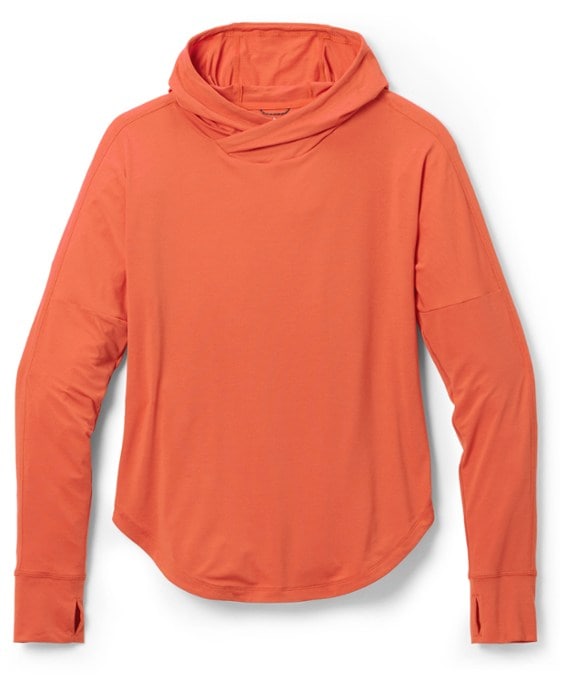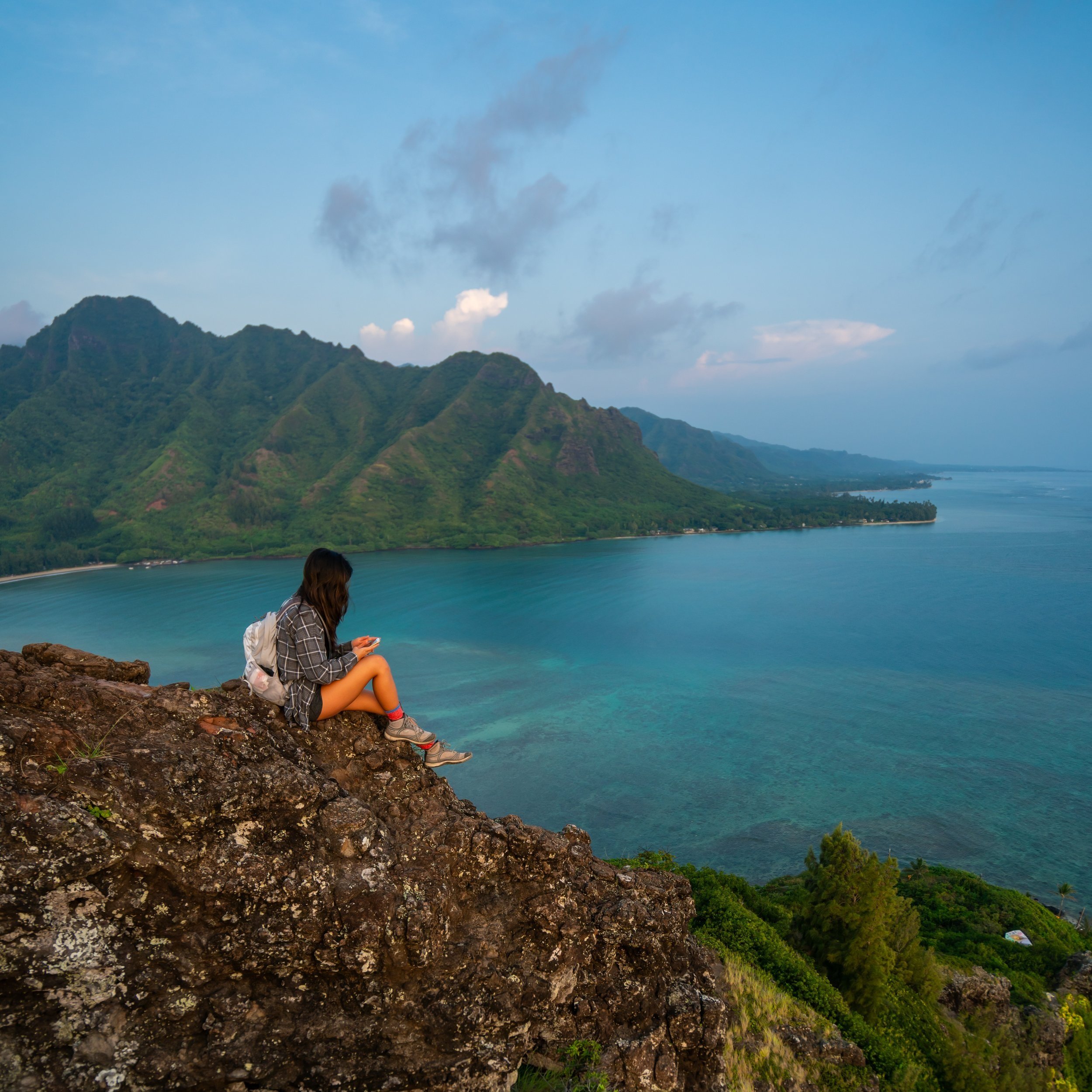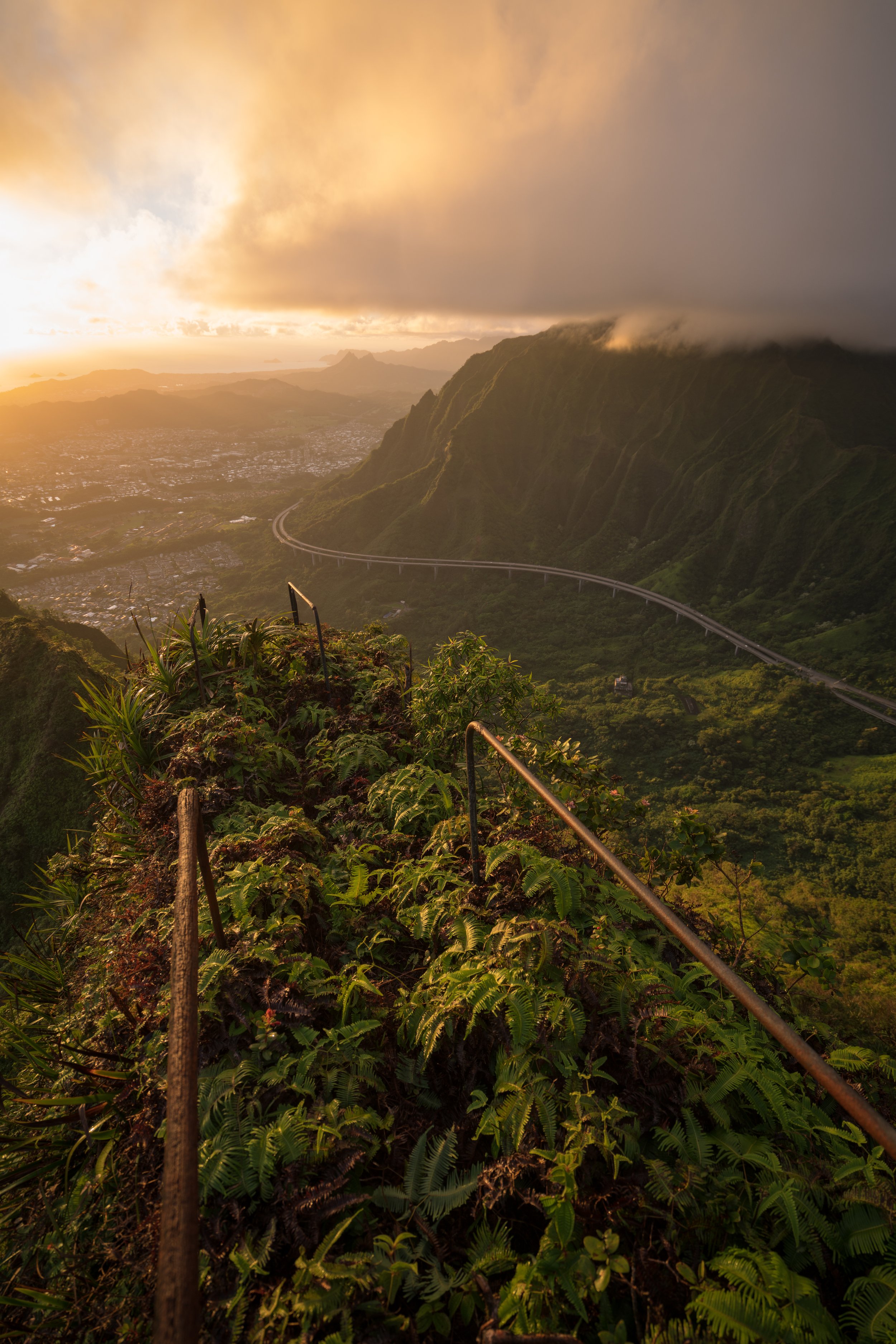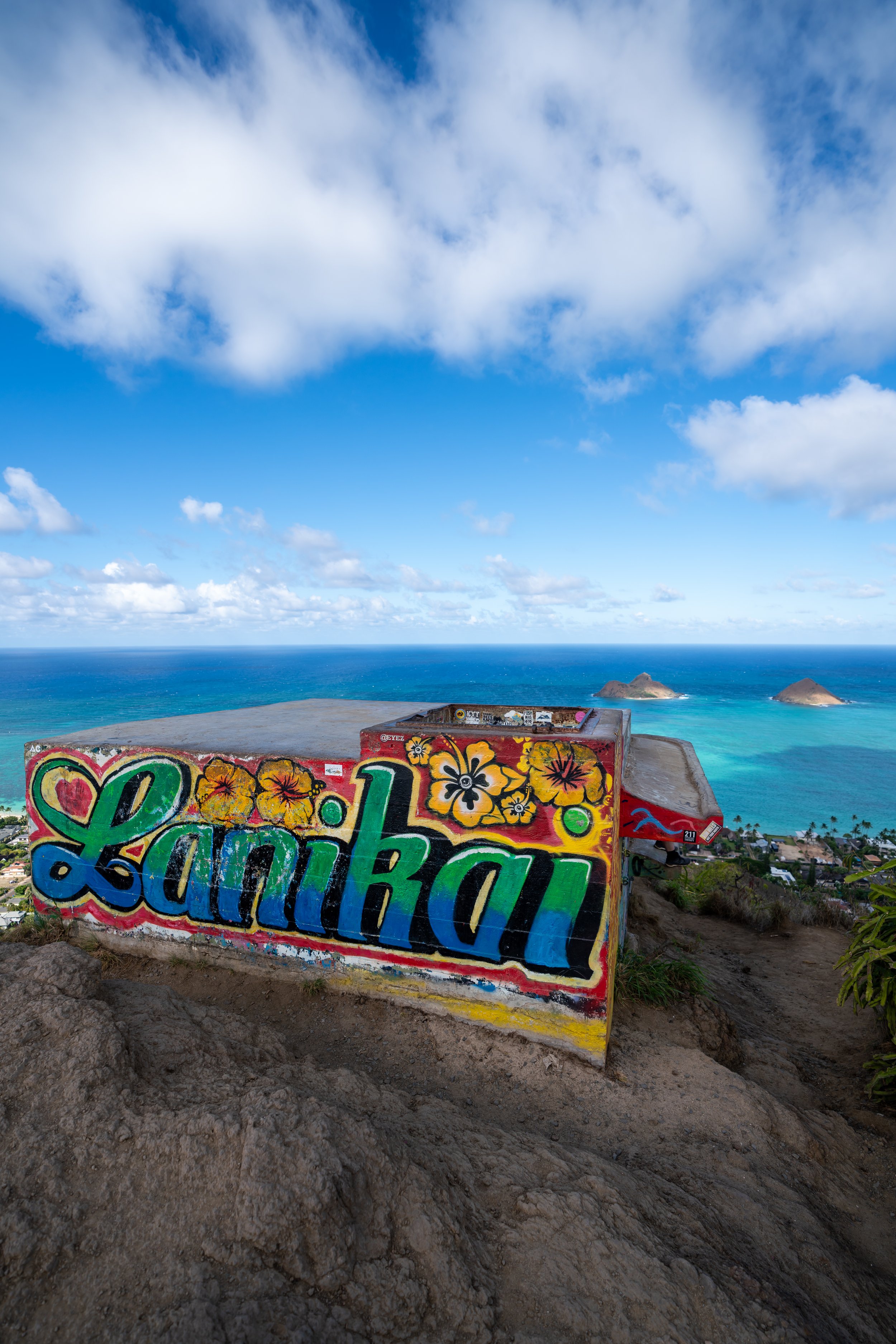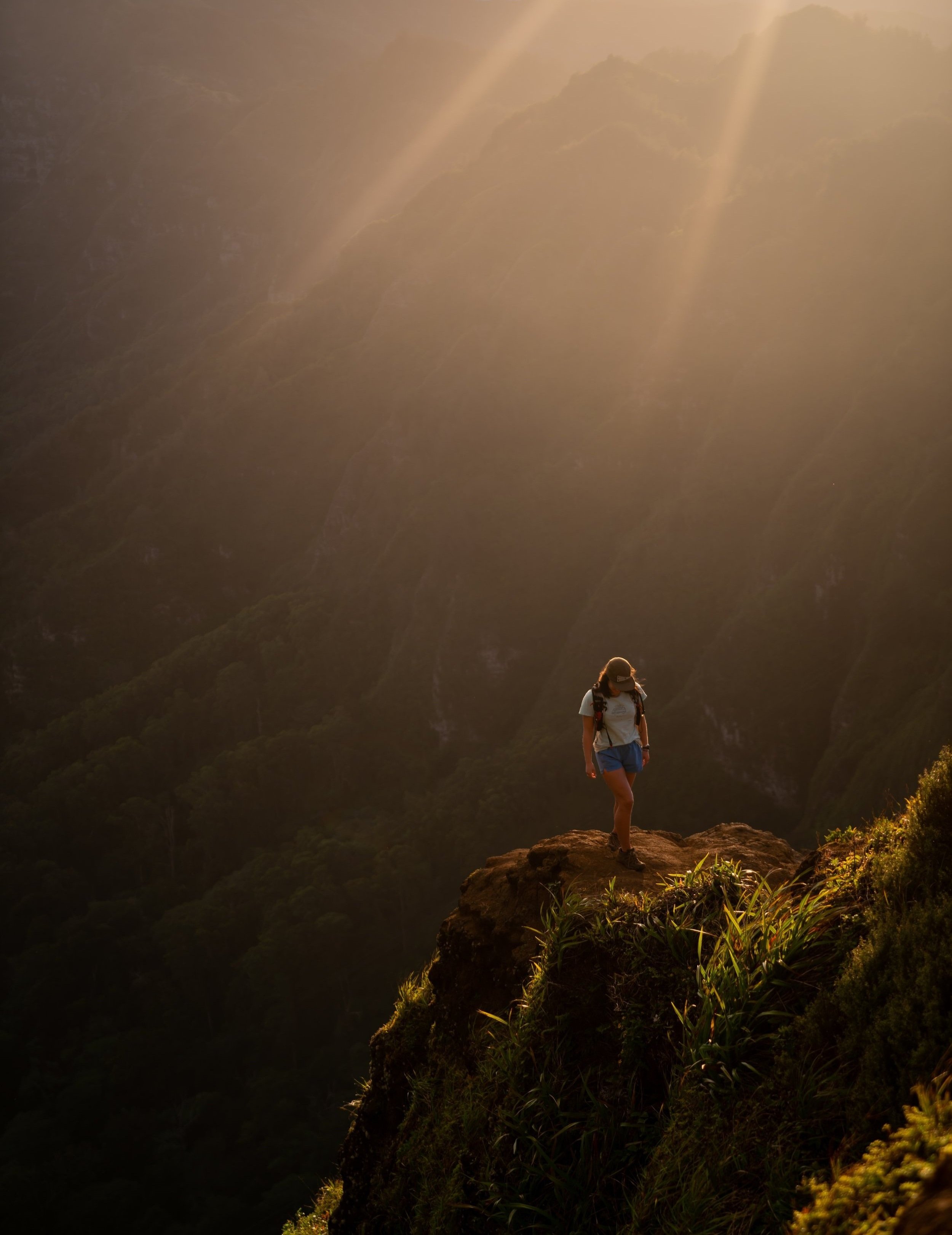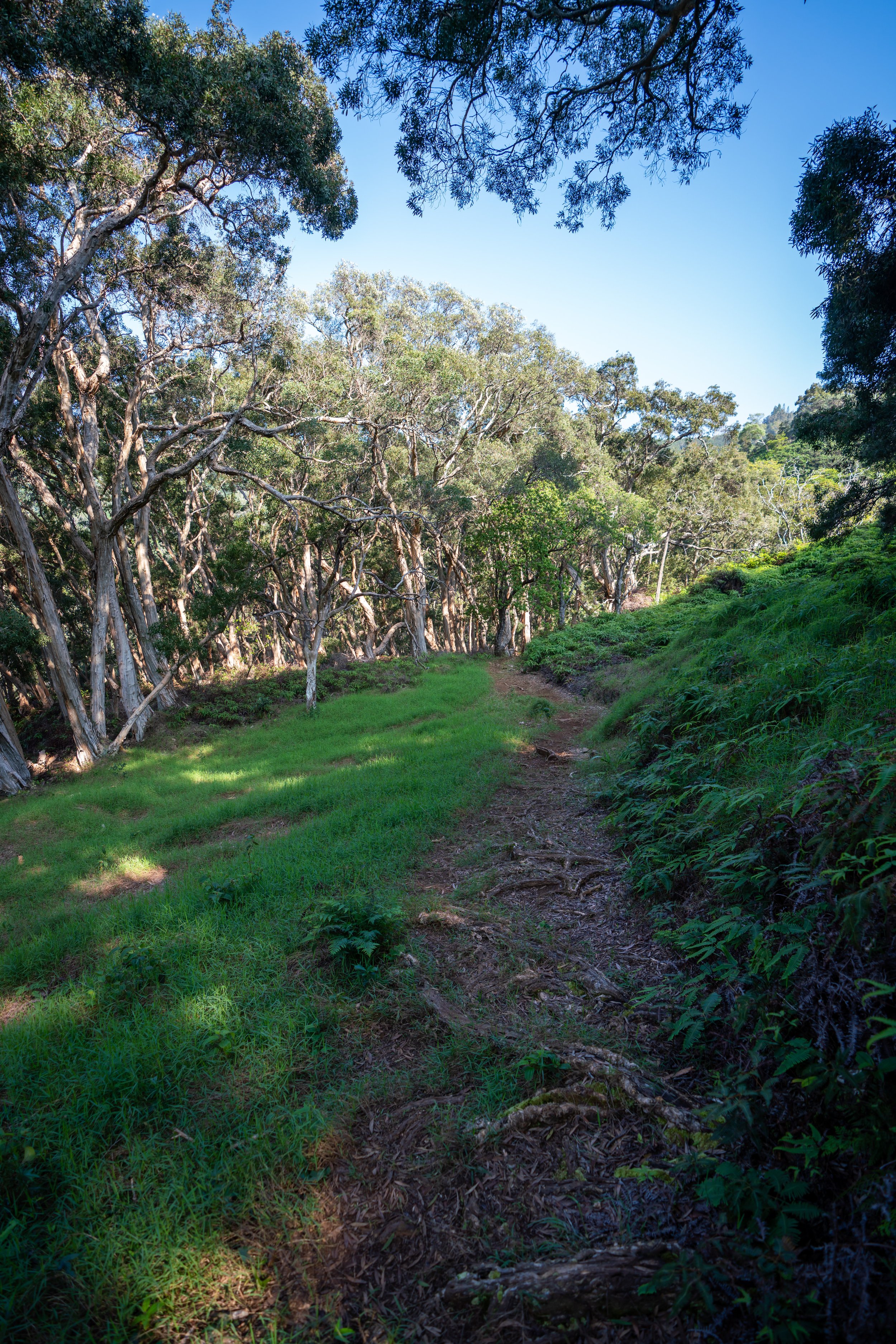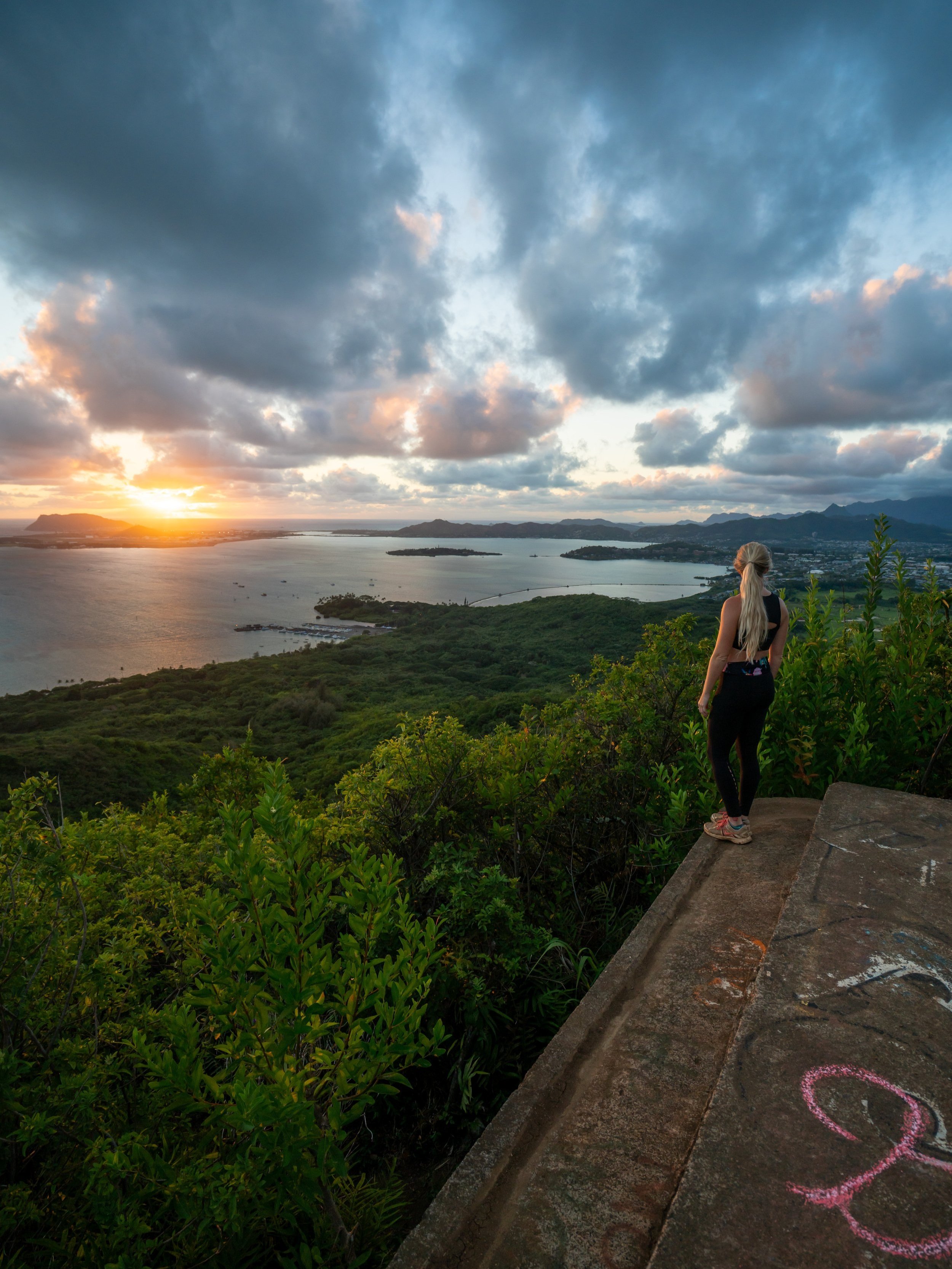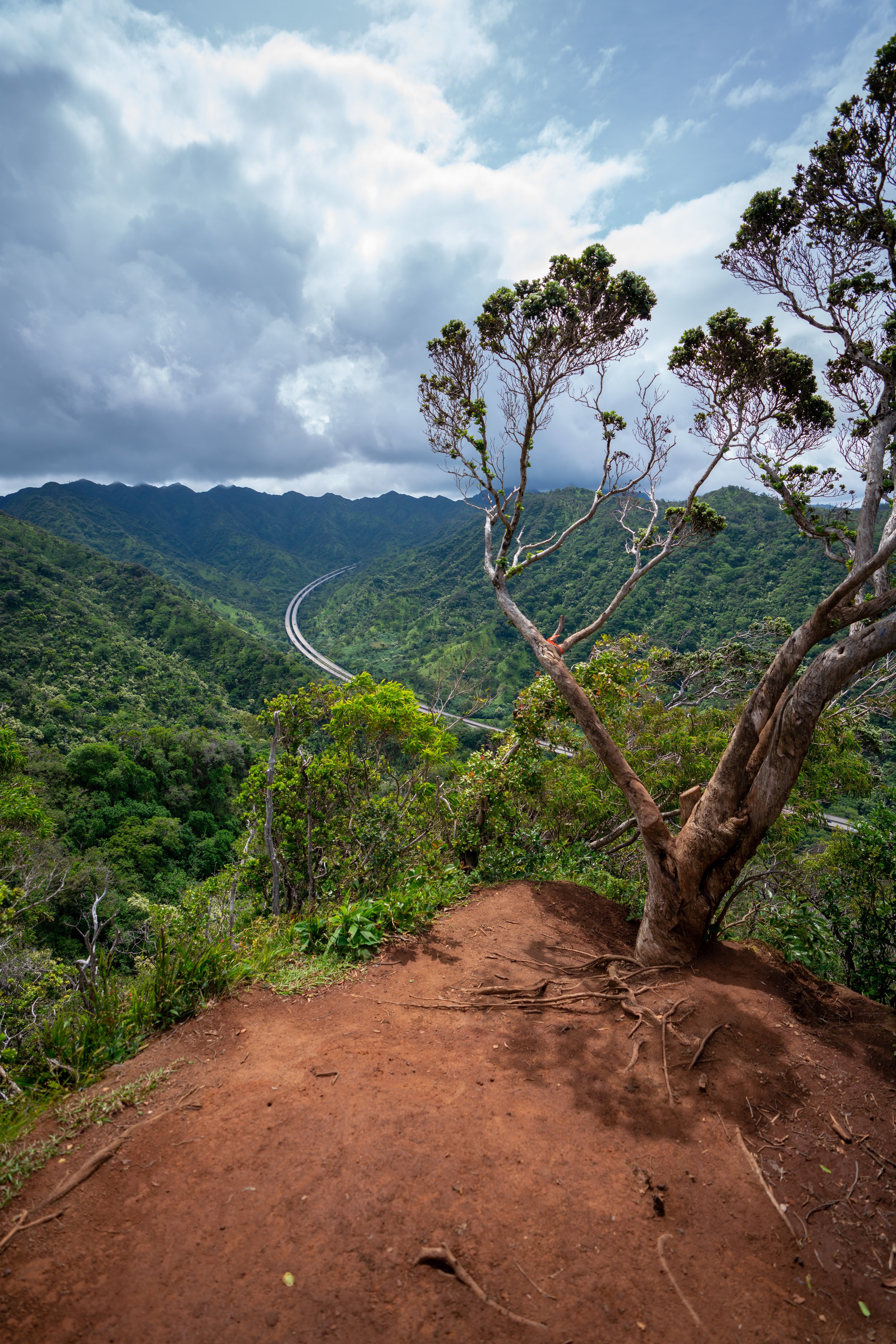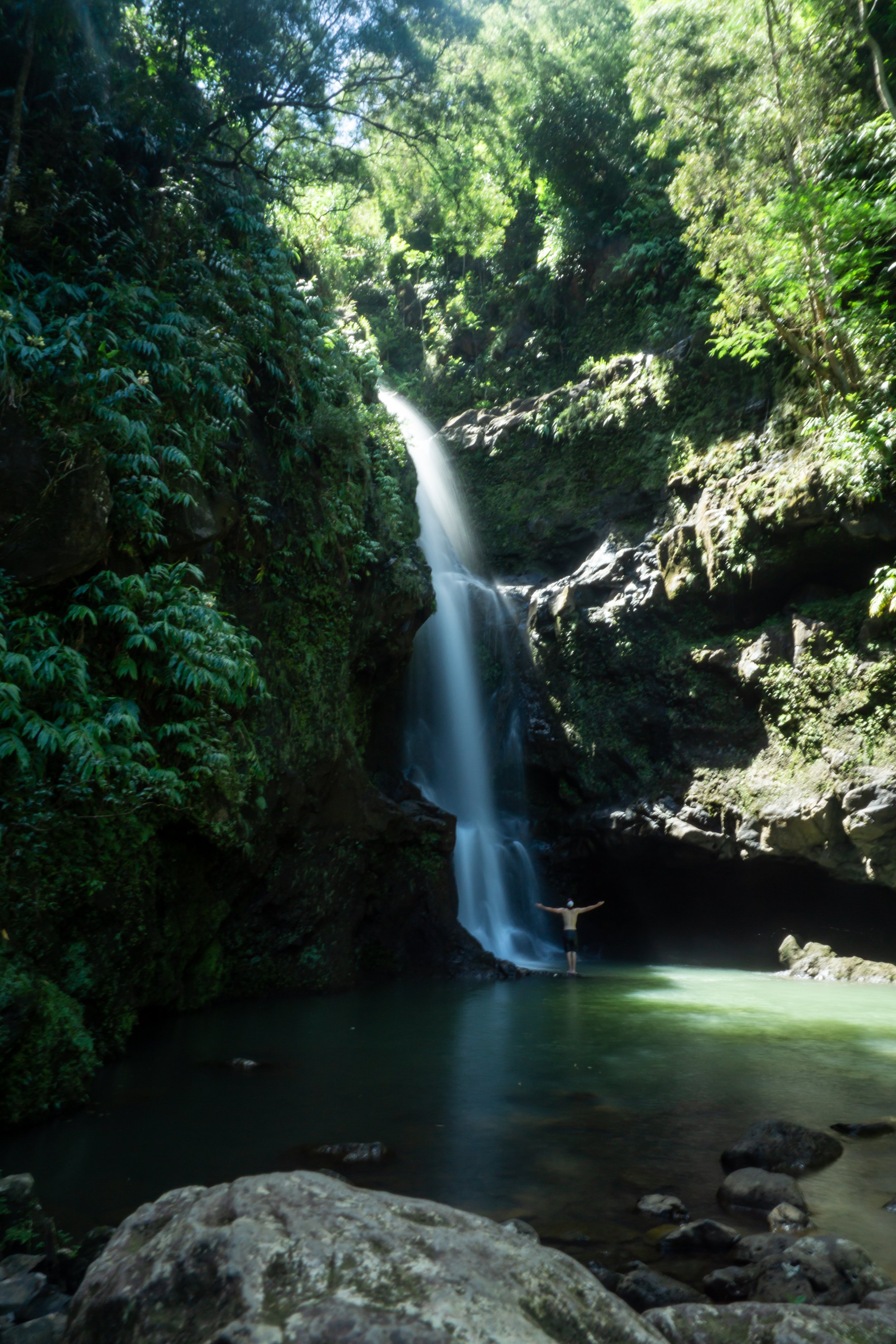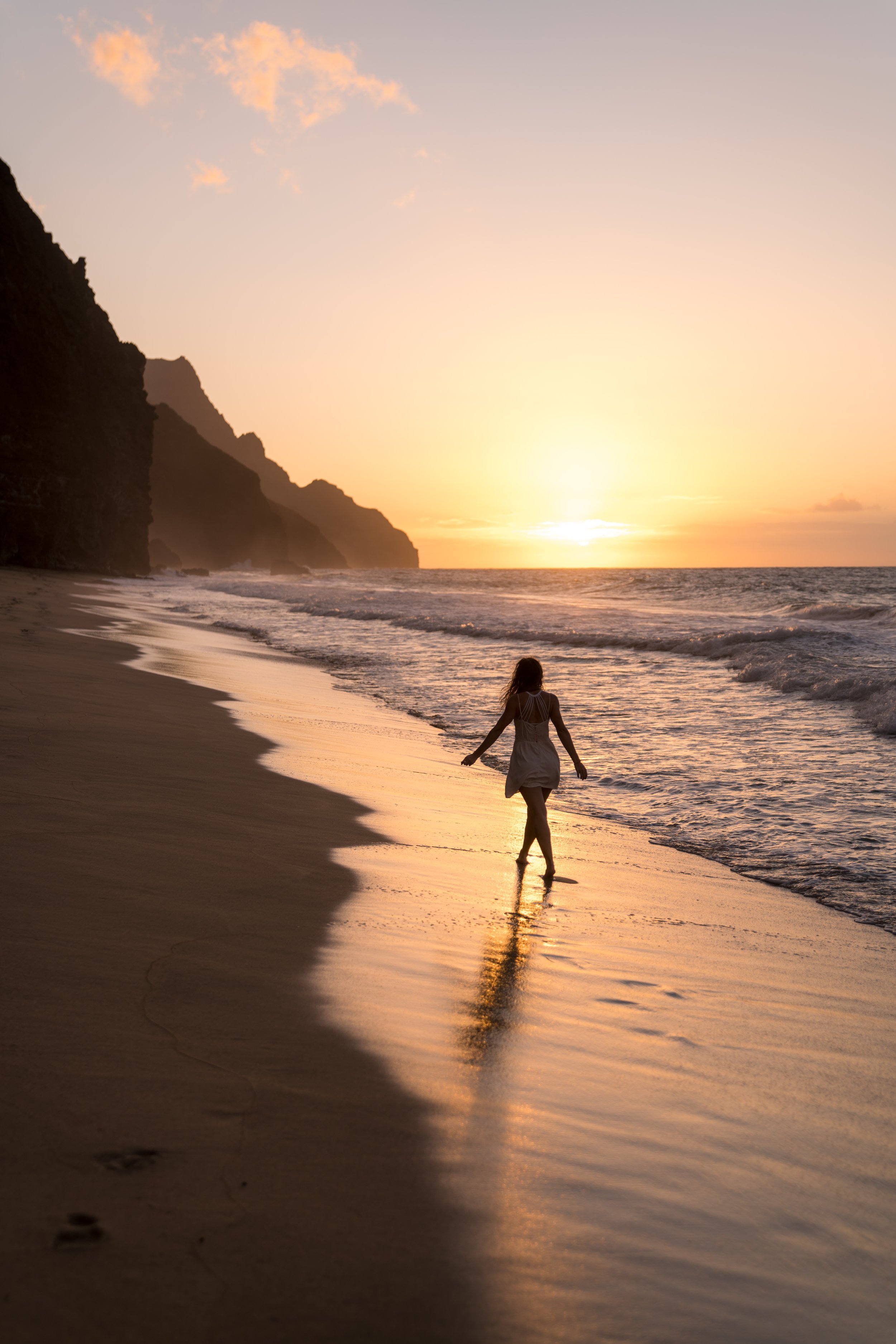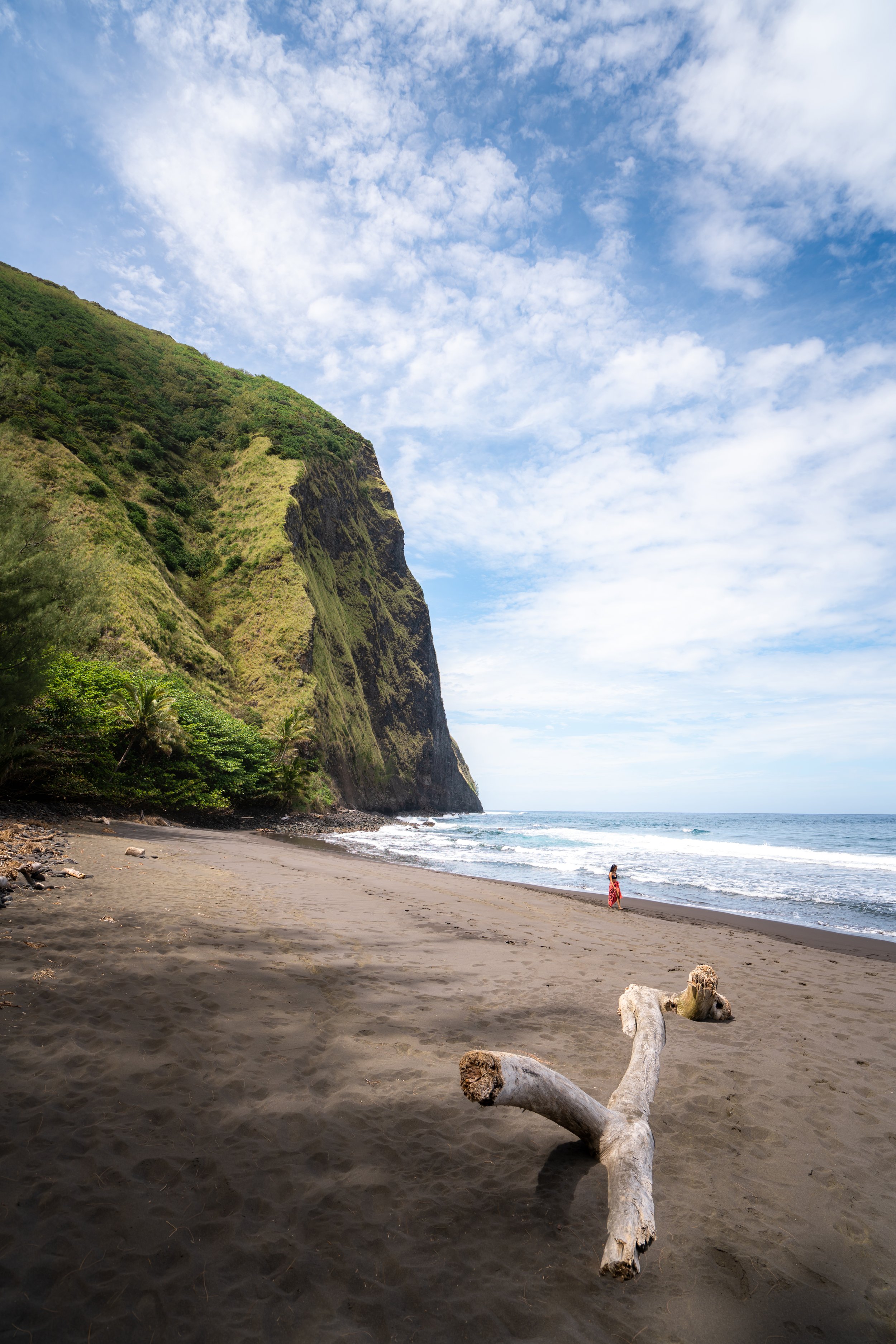Hiking the Keālia Trail on the North Shore of Oʻahu, Hawaiʻi
Distance (Roundtrip to Keālia Shelter): 3.0 miles / 4.8 km
Elevation Gain: ~1,000 ft. / 305 m
Located behind the Kawaihāpai Airfield in Mokulēʻia, formerly known as Dillingham, the Keālia Trail is like the North Shore version of the Koko Crater Stairs in Hawaiʻi Kai.
By this, I mean that just like Koko Head, North Shore residents treat the Keālia Trail like a quick evening workout before sunset.
However, the Keālia Trail is truly a local favorite because of all the different places you can explore past the Keālia Shelter at the top, especially when you hike as far as the Waiʻanae Summit Trail (WST)!
That being said, the distance and the elevation gain above only represent the Keālia Trailhead to the Keālia Shelter at the top of the switchbacks, but if you’re considering hiking further, be sure to read the sections past the shelter, as there a number of different turns to remember in order to hike as far as Kuaokalā and the Waiʻanae Summit.
Connecting Keālia to the Mokulēʻia Access Road
Distance: ~13.0 miles / 20.9 km
One of the most common Waiʻanae Range trail runs is connecting the Keālia Trail with the Mokulēʻia Access Road, utilizing either the Mokulēʻia-Kuaokalā Access Road or the Waiʻanae Summit Trail.
That being said, the total 13-mile (20.9 km) roundtrip distance may sound long, but all parts of the trail move fairly quickly, and the distance above includes the 3.6 miles (5.8 km) along Farrington Highway to get from trailhead to trailhead.
In any case, there’s really no telling how much one can explore past the Keālia Shelter, as there are still new places I’m learning of all the time! However, if you’d like to learn more about the best trail runs on Oʻahu, including the Mokulēʻia Access Road mentioned above, I encourage you to read more in my separate article.
Read My Separate Post: Best Trail Runs on Oʻahu
Keālia Trailhead Parking
Parking for the Keālia Trail is located within the west entrance for the Kawaihāpai Airfield in Mokulēʻia. This is not the same entrance that is used for skydiving.
Furthermore, the Keālia Trail has a designated parking lot within the airfield, but be sure to check the posted times on the Kawaihāpai gate as you drive in because security will lock the gate every night around sunset.
Google Maps Directions: Keālia Trailhead
My Hawaiʻi Hiking Checklist
Osprey 3L Water Bladder - The Osprey 3L water bladder is the most universal hiking and backpacking water bladder on the market, and it’s my go-to because of the slide-off seal that allows it to be quickly filled from the top. Additionally, individual parts are easily replaceable, such as the bite valve.
Blister / Heel Protectors - I swear by these cheap, amazing heel protectors to prevent blisters for nearly every kind of hiking and backpacking that I do!
Black Diamond Headlamp - Personally, I recommend the Black Diamond Storm because it is one of the brightest, lightest, and longest-lasting headlamps on the market—and trust me, the weight-to-battery-life ratio really does matter!
Hiking / Trail Running Shoes - Depending on the type of trail, I prefer to use either the Keen Targhee for longer, more rugged hiking or the HOKA Zinal Trail-Running Shoe for lighter, less intense trails. In either case, both have been amazing to me for many years across countless environments, and both can be found in men’s and women’s sizes. - (Men’s Keen / Women’s Keen) (Men’s HOKA / Women’s HOKA)
Waterproof Rain Shell - You never know when it may rain, and I’ve learned over the years that a rain shell is far better than a rain jacket. By this, I mean that it’s best to have something that the water will roll right off of, which is why I recommend the Patagonia Torrentshell 3L available in both men’s and women’s sizes.
High SPF Sunscreen - Packing high-SPF sunscreen is a must for long days outside!
Hiking the Keālia Trail
The Keālia Trail begins up the short service road that you would have driven past to get to the trailhead parking lot.
Here, go left, and the Keālia Trailhead will be found about 0.25 miles (0.4 km) up the road.
Keālia Trailhead
Once at the trailhead, the Keālia Trail begins climbing a series of about 19 switchbacks—depending on how you count—from the trailhead to the Keālia Shelter at the top.
That being said, the lower elevation switchbacks tend to be slightly longer, but they gradually get shorter and shorter the closer the trail gets to the shelter.
ʻIlieʻe is one of two common native species that can be found along these beginning switchbacks.
As the trail begins to climb above the lower canopy, Wiliwili trees begin to become more and more abundant as the hike goes on.
Around the middle elevations, the canopy essentially disappears altogether, which is why I highly recommend hiking in a hooded sun shirt to be safe!
It’s hard to miss all the beautiful Wiliwilis on the hike up!
This large rock in the trail is from a rockslide that occurred back in 2021.
ʻAʻaliʻi, along with Alaheʻe, are two other common natives that you can expect to see on the Keālia Trail.
Then, after the 16th switchback, the Keālia Trail traverses a distinctly flatter switchback than the rest, which is often regarded as one of the best places on the hike to see some of the expansive views across the Mokulēʻia stretch of Oʻahu’s North Shore.
Keālia Shelter
After climbing all 19 switchbacks to the top, the Keālia Trail ends at the Keālia Shelter, where the Keālia Road begins.
For most hikers, the Keālia Shelter is the end of the trail, but if you’re interested in hiking further in order to see some of the best views in the Waiʻanaes, be sure to read the section below.
Keālia Road (Keālia Shelter to Kuaokalā)
Distance (One Way): 1.8 miles / 2.9 km
The distance above is the one-way distance from the Keālia Shelter to the Kuaokalā Trailhead.
That being said, hiking both the Keālia Trail and Road is my preferred way to hike the Kuaokalā Trail, in order to avoid the hassle of getting the Kuaokalā permit. To learn more about why I say this, I encourage you to read all the details in my separate Kuaokalā article linked below.
In any case, simply follow Keālia Road from the Keālia Shelter, continuing uphill.
Read My Separate Post: Kuaokalā Trail
The main thing to know about hiking from the Keālia Shelter to Kuaokalā is that there are three major hills and a number of turns, all labeled below.
At the first split past the Keālia Shelter, go right to continue on Keālia Road.
The Three Hills on Keālia Road (Hill 1)
Up until this point, Keālia Road constantly climbs uphill, but know that this first hill in the photo below is unmistakable from the rest.
It is, by far, the steepest and longest hill on the hike over to Kuaokalā, meaning the remaining two get easier after the first.
Along Keālia Road, there are a number of native plants that you may see, such as ʻAʻaliʻi, Palaʻā, ʻIliahi, and ʻUkiʻuki, to truly only name a few.
Keālia-Makai Road Junction (Hill 2)
The next split in Keālia Road is the beginning of the second hill.
Here, go left up the hill to continue toward Kuaokalā.
Once at the top of the second hill, Keālia Road, very disappointingly, begins descending back down toward the bottom of the third and final hill.
Hill 3
After climbing and descending the second hill, the third hill immediately follows, which is by far the easiest and most gradual of the three.
Keālia-Mokulēʻia-Kuaokalā Access Road Junction
At the top of the third hill, the Keālia Road ends, where the road to Peacock Flats begins.
At this junction, go left for both the Mokulēʻia Access Road, the Waiʻanae Summit Trail (WST), and the Kuaokalā Trail, as the road to the right simply leads to the Kaʻena Point Space Force Tracking Station.
Access Road-Kuaokalā Trail Junction
At the split in the photo below, go right to continue toward the Kuaokalā Trailhead, located shortly ahead.
East Kuaokalā Trailhead
Finally, after 1.8 miles (2.9 km) of hiking from the Keālia Shelter, the hike across the Waiʻanaes from the North Shore to the West Side ends at the East Kuaokalā Trailhead.
To learn more about hiking the Kuaokalā Trail from this east trailhead, I highly recommend checking out my separate article linked below.
That being said, the East Kuaokalā Trailhead is also where the roads meet the Waiʻanae Summit Trail, which encompasses both the Kuaokalā Trail and the fence line heading east toward Pahole.
Read My Separate Posts: Kuaokalā Trail / Waiʻanae Summit Trail (WST)
Native Plants on the Keālia Trail
Along with the Koko Crater Botanical Garden, the Keālia Trail is the best trail on Oʻahu to find Wiliwili trees growing in their native habitat.
On top of this, other native plants that can be found on the Keālia Trail include Lonomea, ʻIlieʻe, Alaheʻe, ʻAlaʻala wai nui, Kokolau, and Schiedea kealiae, which is endemic only to Oʻahu.
If you would like to learn more about these and many other native Hawaiian plants from across the islands, I encourage you to check out my separate post linked below.
Read My Separate Post: Native Hawaiian Plant Guide
More Oʻahu Adventures
If you’re interested in reading about some more amazing Oʻahu adventures, check out my separate posts below!
Best Hotels & Restaurants in Waikīkī
If you’re trying to decided where to stay on Oʻahu, check out my top 10 list for the best resorts and restaurants in Waikīkī.
I break down what makes one hotel a better choice over another, so that you can find the best fit for your stay on the island.
Read My Separate Post: Best Waikīkī Hotels & Restaurants
HNL Airport-Hotel Shuttle
Prices on ride-share apps like Uber/ Lyft cannot beat the price of booking your hotel shuttle prior to arrival. I say this because there are additional fees for ride-share airport pick-ups at Honolulu Airport (HNL), which is why I recommend booking your transportation in advance using the options below.
Additionally, the last option below will go as far as the Ko ʻOlina Resorts on the West Side and Turtle Bay on Oʻahu’s North Shore!
Best Way to Book Rental Cars!
I travel quite a bit, and I know firsthand that finding a good rental car deal can be a challenge, but that’s why I recommend comparing all of your options with Discover Cars.
In short, Discover Cars is a well-known, reputable business that allows you to search for the best deal across companies, and they have the best full-refund cancellation policy I’ve ever seen, valid up to 72, or sometimes even 48, hours prior to your reservation!
Book Here: Discover Cars
Visiting Other Islands
If you are visiting Oʻahu or heading to another island, check out some of my personal recommendations for Oʻahu, Maui, Kauaʻi, Molokai, Lānaʻi, and Hawaiʻi Island (Big Island) in these separate posts.
If you’re trying to decide which island is right for your visit, check out my overview about each island in the post below.
Read My Separate Post: What is the Best Hawaiian Island to Visit?
What is the Best Time of Year to Visit Hawaiʻi?
The weather in Hawaiʻi can often appear to be warm and beautiful throughout the year, but in my experience, there is a lot more to consider when planning what time of year to visit the islands, such as what island you are considering, what sides of each island do you plan to stay, what activities are you most interested in, the wildlife, and countless other nuanced variables that can all impact the type of trip you can expect to have.
For these reasons, I highly recommend reading through my separate article to not only understand my thoughts regarding the best time of year to come to Hawaiʻi but also what you need to consider based on the time of year that you plan to visit.
Read My Separate Post: What is the Best Time of Year to Visit Hawaiʻi?
10 Best Tours & Excursions on Oʻahu
There are a lot of different tour options to choose from on Oʻahu, but to make it easier to decide, I made a list of my favorite tours because some things simply are better with a local guide!
Read My Separate Post: Best Tours on Oʻahu
Safety
All hikes in Hawaiʻi should not be compared to trails outside of the islands, and hikers should exercise due caution on every adventure, given that many are extremely dangerous.
By this, I mean that Hawaiʻi is known for hot, humid weather, steep, dramatic, and unstable cliffs, and flash floods, which can occur without warning. Therefore, it is important that you check the local forecast, understand the physical condition of your entire group, and pack sufficient food and water before attempting any adventure.
Disclaimer
All information provided on this blog is for informational purposes only and is not intended to be a substitute for information or advice from qualified professionals or managing agencies.
Noah Lang Photography LLC makes no representations or warranties regarding the accuracy or completeness of the information provided here, and readers should use their own discretion, judgement, and seek professional advice where it is appropriate.
Furthermore, Noah Lang Photography LLC shall not be held responsible for any injuries, lost individuals, or legal issues arising from the use of information provided on this website, and if applicable, the above safety disclaimer should be referenced to provide a generic overview of the risks involved.
All said, the content on this blog is for the sole use of Noah Lang Photography LLC, and unauthorized use or reproduction of this content is strictly prohibited.
Disclosure
This post is not sponsored.
However, some of the links in this post are affiliate links, which means that I may earn a small commission if a purchase is made through one of those links. This commission comes at no additional cost to you, and I only recommend products that I personally use and believe will add value to my readers. Thank you for your support, which enables me to continue creating more!
To read the full privacy policy, click here.

About This Blog
Noah Lang Photography, also known as @noahawaii, is 100% reader-supported!
I do not accept guest articles or sponsored content of any kind on my blog, which is why, if you enjoy the outdoor and travel content I create, please consider buying me a coffee!
I appreciate your support, which helps me continue to keep this blog alive!











